Stanford Report, Jan. 28, 2004
Don't just take it for granite: Outdoor art
abounds on campus
Alumnus Toby Schreiber and his wife Rita donated
four works of art that had been on display in the garden of their
Woodside home
BY THERESA JOHNSTON
At first glance, Georgia Granite Circle looks rather simple. The 1990 work by British land artist Richard Long consists of about 100 large chunks of white Georgia granite, all piled on the ground in a circle 16 feet in diameter. But when staffers attempted to install the starkly beautiful piece on the Cantor Center's outdoor art terrace last spring, they found the process anything but easy.

Georgia Granite Circle, on the
Cantor Center’s outdoor art terrace, consists of about 100
large chunks of white Georgia granite weighing more than seven tons
in all. Photo: L.A. Cicero
Hilarie Faberman, the center's curator of modern and contemporary art, says workers first tried placing the boulders around the circle's rim and then filling the interior. But when she saw the piece, she immediately knew that wasn't what the artist had in mind. "It's a pile of stones," she explains, but, if you arrange them from the outside in, it looks different than if you place them across the circle in a series of arcs. Long's written instructions were clear on this point. So Faberman had the staffers pick up the rocks -- more than 7 tons in all -- and start over. It was backbreaking work, she says, "but in the end it was the right thing to do. It's really beautiful."
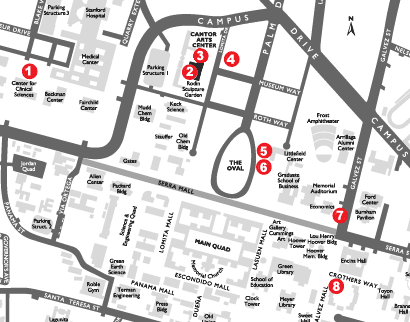
Click on the numbered dots to see photos of the sculptures.
- Mark di Suvero, Miwok
- Claes Oldenburg and Coosje van Bruggen, Floating Peel
- Richard Long, Georgia Granite Circle
- Andy Goldsworthy, Stone River
- Charles Ginnever, Chicago Triangles
- Charles Ginnever, The Three Graces
- Beverly Pepper, Bedford Sentinels
- Linda Fleming, Space Lace
Long's Granite Circle is one of nearly a dozen works of outdoor art that have been acquired, installed or relocated on the Stanford campus during the past eight months. The heavy lifting was prompted in part by a particularly generous gift: four important pieces donated by Stanford alumnus Toby Schreiber, '53, and his wife, Rita. The prominent Bay Area art collectors were moving from their Peninsula home and hoped that Stanford would appreciate having the large works, which had been displayed in their Woodside garden. "Usually at Stanford, outdoor installations happen one at a time," Faberman explains. "But the Schreibers' gift was so substantial, it precipitated a whole lot of moving around."
While Granite Circle is the heaviest of the four Schreiber gifts, Miwok is certainly the tallest. Erected in the garden at the new Center for Clinical Sciences Research, the 29-foot-tall steel sculpture was created by Mark di Suvero, a prominent American sculptor famous for his large-scale works made out of common building materials. As its name suggests, Miwok is reminiscent of a Native American totem, with a towering leg-like frame topped by a head that moves gently in the breeze. The work is more figurative than many of di Suvero's creations and complements his abstract sculpture near the Cantor Arts Center, The Sieve of Eratosthenes.
A third Schreiber gift, The Three Graces, has been installed just off the Oval near the Littlefield Center at the Graduate School of Business. This piece, by San Mateo-born artist Charles Ginnever, consists of three 20-by-4-foot triangular steel panels, each folded and oriented to capture light and shadow in a different way. Chicago Triangles, a similar piece that stood in front of the Schwab Residential Center, has been moved to Littlefield, too. This way, the two Ginnever sculptures can be studied together.

The Three Graces, donated by alumni
Peter and Kirsten Bedford, has just been installed off the Oval
near the Littlefield Center at the Graduate School of Business.
Photo: L.A. Cicero
Campus planners hope to pick out a location for the fourth Schreiber gift, a reclining scrap metal horse by Montana-based sculptor Deborah Butterfield, just as soon as the piece is restored. Such decisions are not made lightly. The President's Panel on Outdoor Art -- which is responsible for the acquisition, siting and care of more than 70 sculptures on campus -- only accepts works by important artists that have some teaching value. The panelists spend a lot of time trekking around the campus looking at potential sites that might frame a piece and be complemented by it. They also talk with donors, the artist, campus architects and the piece's potential neighbors to make sure folks are happy with the decision.
Then there is the challenge of actually moving the work of art. Miwok, for example, is so large that the artist's assistant had to take it apart in Woodside and then weld it back together on campus. Once it was up, a structural engineer had to inspect the towering figure to make sure it would not tip over in an earthquake and hurt someone. "Most people think we just dig a hole and put a sculpture in the ground," Faberman says, "but really it's more like orchestrating a big party."
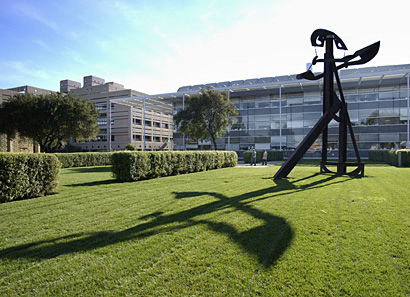
At 29 feet tall, Miwok, by sculptor
Mark di Suvero, is by far the loftiest of recent additions to
Stanford’s outdoor art scene. Donated by alumnus Toby
Schreiber, ’53, and his wife, Rita, the sculpture is
reminiscent of an American Indian totem. The work is more
figurative than many of di Suvero’s creations and complements
his abstract sculpture, The Sieve of Eratosthenes, near the Cantor
Center for Visual Arts. Photo: L.A.
Cicero
She wishes more students, in particular, would give the pieces the respect they deserve. "These are not Frisbee targets," she stresses, "but an enormous aesthetic and monetary asset for the university."
Faberman estimates the total value of the pieces added to Stanford's outdoor sculpture collection during the past eight months alone at nearly $2 million. Among other recent additions and changes in Stanford's outdoor art scene:
- Three abstract bronze figures by American artist Beverly Pepper have been placed at the corner of Serra and Galvez streets, next to the Landau Economics Building. The slender, totem-like objects are named the Bedford Sentinels after Peter and Kirsten Bedford, both members of the Class of '60, who made their fabrication and donation possible.
- Two works by Bay Area artists formerly on view at the Cantor Center's outdoor art terrace have been moved to new sites. Linda Fleming's sculpture Space Lace has been installed on the lawn outside Encina Commons, while Fletcher Benton's 1987 piece Plate Drawing #12, Phase II has been placed in the courtyard of Sequoia Hall, home of the Statistics Department.
- Floating Peel, a 900-pound, 14-foot-tall banana peel by renowned sculptor Claes Oldenburg and his wife and collaborator, Coosje van Bruggen, was installed in the inner courtyard of the Cantor Center on July 31. Stanford will have the piece under loan from the Alturas Foundation of Milton, Mass., for two years.
- Two 600-pound bronze cubes by minimalist artist Toni Smith were donated to Stanford by the artist's estate at the end of 2002. The pieces, which are called For D. G. and For J. W., will be placed at a site to be determined.
Cantor Arts Center docents lead free tours of the outdoor art collection on the first and third Sundays of each month at 2 p.m. year round, rain or shine. First Sunday tours meet at the front of the Main Quad where the Oval meets Serra Street, while third Sunday tours meet in front of the Cantor Center. The tours last about 90 minutes. For more information and an online sculpture map of the campus, go to the Cantor Arts Center website at http://ccva.stanford.edu/.
![]()
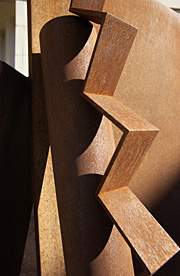
Above, a detail of Plate Drawing #12, Phase II, a 1987 sculpture by Bay Area artist Fletcher Benton, has been placed in the courtyard of Sequoia Hall. Photo: L.A. Cicero
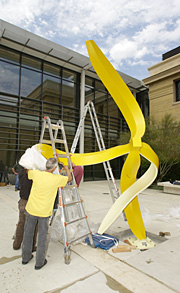
Floating Peel, a 900-pound,
14-foot-tall banana peel by renowned sculptor Claes Oldenburg and
his wife and collaborator, Coosje van Bruggen, was installed in the
inner courtyard of the Cantor Center for Visual Arts. Photo: L.A.
Cicero
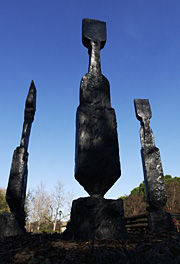
The Bedford Sentinels are named after Stanford alumni Peter and Kirsten Bedford, who donated them to the university. The three abstract bronze figures, by artist Beverly Pepper, have been placed at the corner of Serra and Galvez streets next to the Landau Economics Building. Photo: L.A. Cicero
![]()
